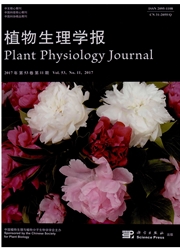

 中文摘要:
中文摘要:
选用‘农大108’(普通玉米)、‘美玉3号’(糯玉米)和‘香甜1号’(甜玉米)种子为材料,分别采用水引发、砂引发、KNO_3和KH_2PO_4混和溶液引发对种子进行处理。引发后,分别进行种子低温发芽试验和幼苗低温生长试验,研究不同引发处理对低温胁迫(5°C)下种子萌发和幼苗生长(3个阶段:5°C低温处理前、5°C低温处理3 d后和25°C恢复生长3 d后)的影响。结果表明:三种引发方法均对三种类型玉米的发芽率没有显著影响,但均显著提高了三种类型玉米种子的发芽势、发芽指数、地上部苗高及苗干鲜重,缩短了平均发芽时间。水引发和砂引发处理均显著降低了三种类型玉米种子的相对电导率,而溶液引发仅显著降低了甜玉米的相对电导率。三种引发处理增加了普通玉米各处理阶段、甜玉米低温处理前和恢复生长3 d后幼苗叶绿素含量以及糯玉米恢复生长3 d后的幼苗叶绿素含量。低温处理前和处理后,水引发增强了三种类型玉米的过氧化物酶(POD)活性;低温处理后,砂引发显著提高了三种玉米的过氧化氢酶(CAT)活性;恢复生长3 d后,砂引发提高了三种类型玉米的POD、CAT和抗坏血酸过氧化物酶(APX)活性,溶液引发均增加了三种玉米的APX活性。三种引发均显著降低了低温处理后糯玉米和甜玉米的丙二醛(MDA)含量。三种引发均提高了普通玉米、糯玉米和甜玉米种子的活力和抗寒性。砂引发更能提高糯玉米种子的活力,水引发更能提高甜玉米种子的活力,对于普通玉米种子三种引发方法差异不明显。
 英文摘要:
英文摘要:
Effects of three priming methods(hydropriming, sand priming, and KNO_3+KH_2PO_4 solution priming) on the germination and seedling growth of normal corn(‘Nongda 108'), waxy corn(‘Meiyu 3') and sweet corn(‘Xiangtian 1') under 5°C low-temperature stress were studied at three stages(before low-temperature stress, after low-temperature stress for 3 d, and after recovering growth at 25°C for 3 d). The r esults show that the three priming methods had no significant effect on germination percentage, however, significantly improved germination energy, germination index, shoot height and shoot dry and fresh weights, and shortened mean germination time in the three types of corns. The re lative conductivity of three types of corns was decreased by hydropriming and sand priming, and the relative conductivity of sweet corn was significantly declined by solution priming. The three priming methods increased chlorophyll content of normal corn in 3 stages and sweet corn before low-temperature stress and after recovering growth at 25°C for 3 d, while chlorophyll content of waxy corn was improved only after recovering growth at 25°C for 3 d. Before low-te mperature stress and after low-temperature stress, hydropriming enhanced the peroxidase(POD) activity of three types of corn. After low-temperature stress for 3 d, sand priming promoted the catalase(CAT) activity of three types of corn. After recovering growth at 25°C for 3 d, sand priming raised the POD, CAT and ascorbate peroxidase(APX) activities of three types of corns, and solution priming increased APX activity of three types of corn. Three priming methods significantly reduced the malondialdehyde(MDA) content of waxy maize and sweet corn after low-temperature stress for 3 d. It suggests that three priming methods could increase seed vigor and improve the chilling tolerant of normal, waxy and sweet corns. Sand priming had advantage in improving seed vigor of waxy corn, and hydropriming showed better improvement for sweet
 同期刊论文项目
同期刊论文项目
 同项目期刊论文
同项目期刊论文
 期刊信息
期刊信息
